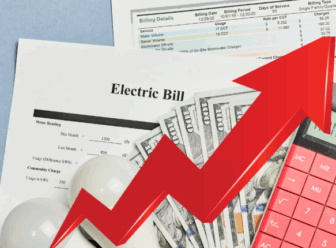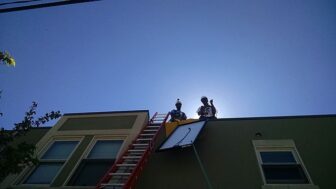The Washington Post featured a local high school’s green renovation in Titans of Ecology, which began
At the brand-new
T.C. Williams High in Alexandria, a modern “green” school, students say the environmentally friendly design has led to a serious lifestyle change: They can’t doze in class anymore because sunlight pours in from practically every angle.
Going green means more attentive students … at least, fewer students napping.This one of those benefits from Going Green, being more environmentally and energy sensitive (aware) when building, that many don’t realize. Putting aside all the environmental benefits (real benefits), being Energy Smart, Environmentally Smart is, well, simply being smart. This points to one of the real benefits of going green, of being environmentally friendly and energy efficient. There are the direct cost savings (estimated at $100,000 per year in lowered energy costs for T.C. Williams with a total additional cost of $1.2 million for going green — and much of that was not energy savings related in terms of additional cost) to be gained through going green.What is less often realized is that those energy savings are not even the tip of the iceberg in real benefits, in measurable impact from “going green”. Study-after-study of green buildings has found that there is improved worker productivity, reduced absenteeism, and improved retention (reduced turnover) which directly impacts the bottom line (helping companies make green by going Green). In addition, related to these is that workers have fewer health problems — working in a healthy space turns out to, surprise surprise, contribute to one’s health.But, how to translate this into the school space?It turns out that there are measures to use … and by those measures, the benefits of going Green have real meaning. From AIA Architect:
This points to one of the real benefits of going green, of being environmentally friendly and energy efficient. There are the direct cost savings (estimated at $100,000 per year in lowered energy costs for T.C. Williams with a total additional cost of $1.2 million for going green — and much of that was not energy savings related in terms of additional cost) to be gained through going green.What is less often realized is that those energy savings are not even the tip of the iceberg in real benefits, in measurable impact from “going green”. Study-after-study of green buildings has found that there is improved worker productivity, reduced absenteeism, and improved retention (reduced turnover) which directly impacts the bottom line (helping companies make green by going Green). In addition, related to these is that workers have fewer health problems — working in a healthy space turns out to, surprise surprise, contribute to one’s health.But, how to translate this into the school space?It turns out that there are measures to use … and by those measures, the benefits of going Green have real meaning. From AIA Architect:
A study in North Carolina revealed that children in schools with more natural day lighting scored 5 percent better on standardized tests than children in normal, comparable buildings.
What is the “value” of that 5 percent test score benefit? How much more would have to be spent on teacher salaries to get that sort of gain? It almost certainly would be far greater than a one-year amortized cost of going Green and increasing natural day lighting.
Thus, the TJ Williams students likely will not just suffer from not having their daytime naps but also suffer through the problem of having higher test scores (perhaps because they are snoring through fewer classes).
The National Academy of Sciences commissioned a study that indicated that teacher productivity and student learning, as measured by absenteeism, is affected by indoor air quality.
In other words, it isn’t just that lighting … the healthier building has a healthy impact on the school environment.Sadly, the Post articlegave voice to shallow-based criticism.
The new three-story T.C. Williams, home to about 2,000 students, cost about $98 million, which is much higher than the price of many regular high schools its size. Alexandria school officials said the facility’s green features account for about $1.2 million of its cost. Still, some educators and parents expressed skepticism about the cost of green schools.John Wilson, a commercial real estate salesman and the father of student J.W. Wilson, said he was surprised that he had not heard much protest about the school’s cost. “I am happy that the students have the best of everything,” Wilson said, “but I am not convinced that it always translates into a better education.”
Well, the “best of everything”. Is Wilson focused on and upset about the $98 million? Or, is it the $1.2 million of greening that’s got his goat? And well, again that $1.2 million will translate to $100,000 per year in lower energy costs, could reduce other direct costs (substitute teachers, health care compensation, etc), could lead to improved student health/happiness, and will, almost certainly, translate into improved academic performance of higher value than that $1.2 million each and every year.All told, for the citizens, that $1.2 million looks like a pretty good investment.Well, TJ Williams is not isolated. The latest issue of Eco-Structure has a focus, principally, on green schools. One discussion was on Guilford Northern Middle School in Greensboro, NC.
Michael Nicklas, project architect, said, “If educational buildings are respectful of the environment, the students will consider environmental stewardship an important value. Our schools should make a strong statement that saving energy and protecting the environment are important. The message that we give to future generations, through the schools we build for them, should not be underestimated.”
What are some of the school’s features?
- daylighting will provide natural light at full-lighting levels to classrooms, administrative offices, the media center, the gymnasium, and the cafeteria during two-thirds of the school’s operating hours.
- Reflective white roofing to cool the roof & reduce the HVAC requirements. “Lower lighting and cooling needs are expected to reduce initial costs by $150,000 and, correspondingly, air conditioning by 70 tons.”
- Solar hot water for the kitchen, saving 1,747 therms per year. A solar photovoltaic system located between the greenhouses near the sixth-grade science room will generate supplemental electricity.
- An “under-floor air distribution system for all classrooms, the media center, and administrative offices” improves energy efficiency and makes the environment healthier.
- The “sustainable features are interconnected by computerized monitoring systems and visible to students. Coupled with the science curriculum, these features will provide experiential learning material that can influence the way students look at their environment.”
And, let us be clear, that sort of savings is not out-of-line, if anything it is relatively low from what might be realized. The best work in this realm is perhaps Capital E‘s Greening America’s SchoolsSome 55 million students spend their days in schools that are too often unhealthy and that restrict their ability to learn.Anyone having lived through public education question this one?
Conventional schools are typically designed just to meet building codes – that are often incomplete. Design of schools to meet minimum code performance tends to minimize initial capital costs but delivers schools that are not designed specifically to provide comfortable, productive, and healthy work environments for students and faculty.
In other words, there is a focus on cost to buy rather than the total cost to own, a problem throughout American culture. There is a perception — increasingly incorrect — that it is more expensive to build energy efficient, more expensive to build green. Even if more expensive to buy energy efficient, it is generally far less expensive to own.This national review of 30 green schools demonstrates that green schools cost less than 2% more than conventional schools – or about $3 per square foot ($3/ft2) – but
provide financial benefits that are 20 times as large. Greening school design provides an extraordinarily cost-effective way to enhance student learning, reduce health and operational costs and, ultimately, increase school quality and competitiveness.Even with discounting for Net Present Value at a (high) discounting rate of 7%, just the energy savings has a value three times higher than the extra cost. Then there there are the health benefits (students and teachers), teacher retention, water savings, etc … The highest value, however, seems to go back to the test scores. Future earning potential (with the discounting rate) has about 16 times the value of the cost of going green when building (or renovating) a school according to this school. To the extent that earning potential is an indicator of school performance, this suggests that Going Green in school buildings might be one of the most cost-effective things the nation can due to enhance public school performance — even without considering the energy savings and all of the other financial benefits. In the end, Greening the Schools means improving student performance at a negative cost — e.g., it would cost less while saving money and polluting less. What I wonder? What are we waiting for?Now, Energize America‘s Energy Smart Communities Act (ESCA) bonds would help provide the resources for communities across the nation to accelerate this very type of investment. Programs that would save energy, save money, while also providing a healthier and more productive environment for our children. NOTES
- Version orginally posted at Energy Smart.




